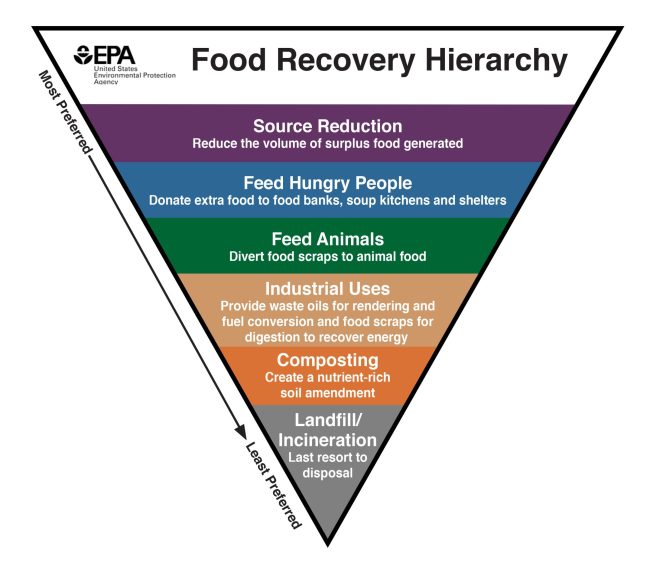Approximately ⅓ – or 1.3 billion tons – of food is wasted annually, posing a critical humanitarian and environmental issue (2021 UNEP Food Waste Index). Composting is one of five actions outlined in the Food Recovery Hierarchy that should be taken to prevent and divert food waste from landfills.

Source Reduction
The first step toward food waste reduction should be to stop the creation of food waste at the source. This can be done by meal planning to minimize excess food, finding creative ways to use food that is nearing the end of its useful life, and storing or preserving food in ways that keep it fresh for as long as possible. Check out Save the Food and a video with tips for reducing food waste.
Feed Hungry People
Using excess food to feed hungry people avoids wasting the resources and emissions generated throughout the food production process, while also helping to address food insecurity and malnutrition in one’s own community. To donate food, explore local food recovery organizations and food pantries accepting donations. Check out the Food Waste and Recovery Guide for Madison and Dane County.
Feed Animals
At the household level, feeding animals can be a practical way to dispose of food waste—especially fruit and vegetable scraps. For example, backyard chickens can eat many types of fruit and vegetable scraps. Be sure to check any local ordinances that regulate livestock feed. Check out Using Food Waste as Livestock Feed.
Industrial Uses
This refers to disposal options for food waste that convert it into a usable form, often some type of fuel. While industrial use options for food waste are currently limited, Dane county has taken steps in developing their Sustainability Campus that will establish composting sites and anaerobic digesters that would accept regional food scraps.
Composting
Composting is a more sustainable option than landfilling because it returns organic material to local soils, improving soil health and carbon sequestration, and reducing the methane emissions generated by landfills. To learn more about composting, take our course on home composting, explore local commercial food scrap collection options, and check out our resources.
Landfill/Incineration

Landfilling and incineration should be the last resort to disposing of food waste, and can be avoided by following the steps listed above. The Dane County Landfill accepts waste from Dane County residents and businesses.




